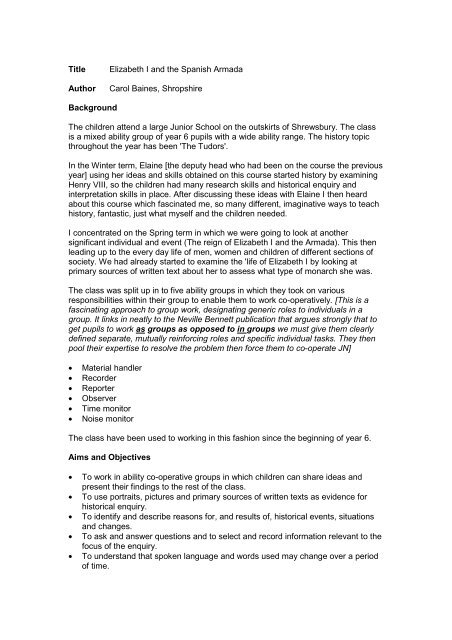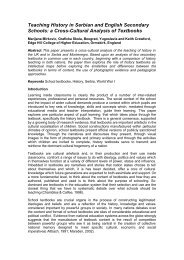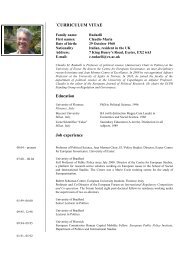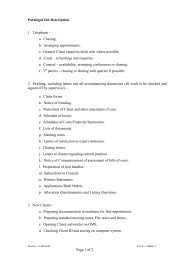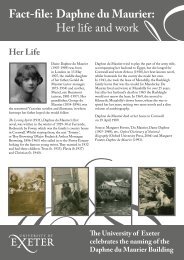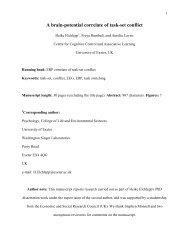Title Elizabeth I and the Spanish Armada Author Carol Baines ...
Title Elizabeth I and the Spanish Armada Author Carol Baines ...
Title Elizabeth I and the Spanish Armada Author Carol Baines ...
Create successful ePaper yourself
Turn your PDF publications into a flip-book with our unique Google optimized e-Paper software.
<strong>Title</strong> <strong>Elizabeth</strong> I <strong>and</strong> <strong>the</strong> <strong>Spanish</strong> <strong>Armada</strong><br />
<strong>Author</strong> <strong>Carol</strong> <strong>Baines</strong>, Shropshire<br />
Background<br />
The children attend a large Junior School on <strong>the</strong> outskirts of Shrewsbury. The class<br />
is a mixed ability group of year 6 pupils with a wide ability range. The history topic<br />
throughout <strong>the</strong> year has been 'The Tudors'.<br />
In <strong>the</strong> Winter term, Elaine [<strong>the</strong> deputy head who had been on <strong>the</strong> course <strong>the</strong> previous<br />
year] using her ideas <strong>and</strong> skills obtained on this course started history by examining<br />
Henry VIII, so <strong>the</strong> children had many research skills <strong>and</strong> historical enquiry <strong>and</strong><br />
interpretation skills in place. After discussing <strong>the</strong>se ideas with Elaine I <strong>the</strong>n heard<br />
about this course which fascinated me, so many different, imaginative ways to teach<br />
history, fantastic, just what myself <strong>and</strong> <strong>the</strong> children needed.<br />
I concentrated on <strong>the</strong> Spring term in which we were going to look at ano<strong>the</strong>r<br />
significant individual <strong>and</strong> event (The reign of <strong>Elizabeth</strong> I <strong>and</strong> <strong>the</strong> <strong>Armada</strong>). This <strong>the</strong>n<br />
leading up to <strong>the</strong> every day life of men, women <strong>and</strong> children of different sections of<br />
society. We had already started to examine <strong>the</strong> 'life of <strong>Elizabeth</strong> I by looking at<br />
primary sources of written text about her to assess what type of monarch she was.<br />
The class was split up in to five ability groups in which <strong>the</strong>y took on various<br />
responsibilities within <strong>the</strong>ir group to enable <strong>the</strong>m to work co-operatively. [This is a<br />
fascinating approach to group work, designating generic roles to individuals in a<br />
group. It links in neatly to <strong>the</strong> Neville Bennett publication that argues strongly that to<br />
get pupils to work as groups as opposed to in groups we must give <strong>the</strong>m clearly<br />
defined separate, mutually reinforcing roles <strong>and</strong> specific individual tasks. They <strong>the</strong>n<br />
pool <strong>the</strong>ir expertise to resolve <strong>the</strong> problem <strong>the</strong>n force <strong>the</strong>m to co-operate JN]<br />
• Material h<strong>and</strong>ler<br />
• Recorder<br />
• Reporter<br />
• Observer<br />
• Time monitor<br />
• Noise monitor<br />
The class have been used to working in this fashion since <strong>the</strong> beginning of year 6.<br />
Aims <strong>and</strong> Objectives<br />
• To work in ability co-operative groups in which children can share ideas <strong>and</strong><br />
present <strong>the</strong>ir findings to <strong>the</strong> rest of <strong>the</strong> class.<br />
• To use portraits, pictures <strong>and</strong> primary sources of written texts as evidence for<br />
historical enquiry.<br />
• To identify <strong>and</strong> describe reasons for, <strong>and</strong> results of, historical events, situations<br />
<strong>and</strong> changes.<br />
• To ask <strong>and</strong> answer questions <strong>and</strong> to select <strong>and</strong> record information relevant to <strong>the</strong><br />
focus of <strong>the</strong> enquiry.<br />
• To underst<strong>and</strong> that spoken language <strong>and</strong> words used may change over a period<br />
of time.
• To communicate <strong>the</strong>ir knowledge <strong>and</strong> underst<strong>and</strong>ing of history in a variety of<br />
ways: Newspaper article, poetry, letter <strong>and</strong> diary extracts.<br />
Learning Outcomes<br />
• Enjoyment in history lessons.<br />
• Confidence in interpreting <strong>and</strong> using evidence from portraits, pictures <strong>and</strong> primary<br />
sources of written text, gaining a positive attitude towards research also in<br />
h<strong>and</strong>ling more complex text <strong>and</strong> decoding meaning.<br />
• Knowledge about significant events (<strong>Armada</strong>, Queen <strong>Elizabeth</strong> I <strong>and</strong> The speech<br />
at Tilbury) <strong>and</strong> characters (Queen <strong>Elizabeth</strong> I, Phillip II, Sir Francis Drake, Lord<br />
Howard <strong>and</strong> Medina Sidonia).<br />
• Empathy with seamen, how <strong>the</strong>y lived <strong>and</strong> worked.<br />
Resources<br />
• The <strong>Armada</strong> portrait of Queen <strong>Elizabeth</strong> I.<br />
• The <strong>Armada</strong> build up information sheet.<br />
• The <strong>Armada</strong> simulation game. (This is downloadable from <strong>the</strong> Nuffield<br />
Foundation web site)<br />
• Account of <strong>the</strong> storms of Autumn 1588 written by a survivor from <strong>the</strong> wreck of<br />
Gran Grifon on Fair Isle.<br />
• Picture of <strong>Elizabeth</strong> I <strong>and</strong> <strong>the</strong> public procession to Tilbury in Essex to encourage<br />
her troops.<br />
• Speech given by <strong>Elizabeth</strong> to her troops at Tilbury.<br />
Year Group<br />
I Class: Year 6 Class, twenty six children of mixed gender <strong>and</strong> ability.<br />
Teaching time<br />
Six lessons, each lasting approximately one hour<br />
Teaching Activities for <strong>the</strong> Scheme of Work – <strong>the</strong> six lessons<br />
1) Looking for clues from <strong>Elizabeth</strong>'s <strong>Armada</strong> portrait, introduction leading to work<br />
on <strong>the</strong> <strong>Armada</strong>.<br />
Children asking <strong>and</strong> answering question.<br />
Presentation to class.<br />
2) The <strong>Armada</strong> build up. Finding out reasons <strong>and</strong> discussing new vocabulary, use of<br />
dictionary to determine meanings.<br />
Presentation to class.<br />
3) The <strong>Armada</strong> simulation (used for course) resulting in writing a newspaper report<br />
from <strong>the</strong> <strong>Spanish</strong> or English point of view.<br />
4) Thoughts <strong>and</strong> feeling, 'Life on a Galleon', h<strong>and</strong>ling of more complex text<br />
structure, particulary decoding meaning. Empathy skills, what it was like for<br />
sailors I soldiers aboard.<br />
Choice: Poetry, letter or diary extract.
5) The speech at Tilbury. Using a picture of this event, children to determine what<br />
<strong>the</strong>y think is happening, who <strong>the</strong> most important person is, why <strong>the</strong>y are <strong>the</strong>re,<br />
thoughts of people <strong>and</strong> sounds heard creating an atmosphere.<br />
Presentation to class.<br />
6) Oral discussion about Queen <strong>Elizabeth</strong>'s speech at Tilbury. Discussion on<br />
whe<strong>the</strong>r we thought <strong>Elizabeth</strong>'s speech was dishonest, why leaders often give<br />
stirring speeches <strong>and</strong> what <strong>the</strong> hungry sailors might have thought about her<br />
speech .<br />
Lesson 1 Looking for clues (<strong>Elizabeth</strong>'s <strong>Armada</strong> portrait) one hour.<br />
Key Questions<br />
1 ) What does <strong>the</strong> portrait tell us?<br />
2) What can we infer?<br />
3) What does it not tell us?<br />
The children had already sorted out <strong>the</strong>ir roles within <strong>the</strong>ir cooperative groups <strong>and</strong><br />
were ready to work co-operatively. Each group had a colour copy, A3 size of <strong>the</strong><br />
portrait.<br />
Discussion about how a portrait can give us clues about a person <strong>and</strong> events that<br />
happened at that particular time. Brain stormed words associated with picture <strong>and</strong><br />
some questions we would have like to have asked <strong>the</strong> artist about <strong>the</strong> portrait. We<br />
discussed how <strong>the</strong> face, body language, dress, props <strong>and</strong> setting <strong>and</strong> <strong>the</strong> wishes of<br />
<strong>the</strong> client <strong>and</strong> <strong>the</strong> artists role all give us clues.<br />
We discussed <strong>the</strong> three key questions. The children straight away realised that it was<br />
a portrait of Queen <strong>Elizabeth</strong>,<strong>and</strong> that she had something to do with <strong>the</strong> <strong>Spanish</strong><br />
<strong>Armada</strong> which led on nicely to do more research about what happened with <strong>the</strong><br />
<strong>Spanish</strong> <strong>Armada</strong>.<br />
Children completed sheet in co-operative groups. At <strong>the</strong> end of <strong>the</strong> session each<br />
group shared <strong>and</strong> discussed finding. Opportunity for children to listen to each o<strong>the</strong>r<br />
<strong>and</strong> discuss in an appropriate manner.<br />
Lesson 2: The <strong>Armada</strong>, <strong>the</strong> build up, one hour.<br />
Key Questions<br />
1) What led to <strong>the</strong> battle between <strong>the</strong> English (<strong>Elizabeth</strong> I) <strong>and</strong> <strong>the</strong> <strong>Spanish</strong> (Phillip<br />
II)?<br />
2) Which of <strong>the</strong> reasons do you think was <strong>the</strong> main one<br />
Working in Co-operative groups.<br />
Read through toge<strong>the</strong>r 'The <strong>Armada</strong> <strong>the</strong> build up' sheet, highlighting any words didn't<br />
underst<strong>and</strong> <strong>the</strong> meaning of (looked up in dictionaries). Highlighted map of Europe,<br />
determining which countries followed which religion. Discussed with children <strong>the</strong><br />
results of this <strong>and</strong> answered question: Who was Phillip II?<br />
At <strong>the</strong> end of this session each group explained <strong>the</strong>ir reasoning behind choosing <strong>the</strong>ir<br />
main reason which led up to <strong>the</strong> battle.
Opportunity for children to listen to each o<strong>the</strong>r <strong>and</strong> discuss <strong>the</strong> reasons in an<br />
appropriate manner.<br />
Lessons 3 The <strong>Spanish</strong> <strong>Armada</strong> simulation (obtained from <strong>the</strong> course) two, one<br />
hour sessions.<br />
Key Question<br />
1) What factors influenced <strong>the</strong> admirals of <strong>the</strong> English <strong>and</strong> <strong>Spanish</strong> fleets during <strong>the</strong><br />
<strong>Spanish</strong> <strong>Armada</strong> campaign?<br />
Taught exactly from Jon Nichol's lesson plan. After discussing <strong>the</strong> outcomes <strong>the</strong><br />
children <strong>the</strong>n used <strong>the</strong>ir writing frames to write a <strong>Spanish</strong> or English newspaper<br />
article depending on which side <strong>the</strong>y were on.<br />
Lesson 4: Thoughts <strong>and</strong> feelings 'Life on a Galleon' one hour.<br />
Key Question<br />
1) How would a person aboard a ship during <strong>the</strong> <strong>Spanish</strong> <strong>Armada</strong> have felt about<br />
his experiences at sea?<br />
We read through <strong>the</strong> account from <strong>the</strong> survivor of <strong>the</strong> wreck. Determining meanings<br />
of more difficult vocabulary <strong>and</strong> what he was trying to write. In co-operative groups<br />
children discussed what this man would have thought <strong>and</strong> how he felt. Discussed as<br />
a class <strong>and</strong> bullet pointed on easel. Introduced empathy. I <strong>the</strong>n gave <strong>the</strong> children a<br />
choice in which <strong>the</strong>y could write a poem, letter or diary extract of this mans thoughts<br />
<strong>and</strong> experiences aboard <strong>the</strong> ship <strong>and</strong> how he survived.<br />
Lesson 5: Speech at Tilbury picture, one hour.<br />
Key Questions<br />
1) What do you think is happening in <strong>the</strong> picture?<br />
2) Who do you think <strong>the</strong> most important person is?<br />
3) Why are <strong>the</strong>y <strong>the</strong>re?<br />
4) What thoughts would be going through her mind?<br />
5) What sounds could be heard?<br />
The children worked in co-operative groups, each group had a copy of 'Public<br />
Procession to Tilbury' picture. To get <strong>the</strong> children to study <strong>the</strong> picture closely we had<br />
a game of eye spy (ten minutes). One child said 'E' <strong>and</strong> <strong>the</strong>n ano<strong>the</strong>r child guessed<br />
'<strong>Elizabeth</strong>' this went on, for example <strong>the</strong> child who had guessed <strong>Elizabeth</strong> <strong>the</strong>n said<br />
C, ano<strong>the</strong>r pupil <strong>the</strong>n said Crescen<br />
'C' = Crescent<br />
'F' = Fleet <strong>and</strong> so on.<br />
So already <strong>the</strong> children had obtained information about what was happening in <strong>the</strong><br />
picture. Then in <strong>the</strong>ir co-operative groups <strong>the</strong>y <strong>the</strong>n went onto answer <strong>the</strong> key<br />
questions. At <strong>the</strong> end of <strong>the</strong> session <strong>the</strong> children discussed what <strong>the</strong>y had written <strong>and</strong><br />
why.<br />
Lesson 6 The Speech at Tilbury, oral session, twenty minutes
Key Questions<br />
1) Do you think <strong>Elizabeth</strong> was honest?<br />
2) Why do leaders give speeches in times of trouble?<br />
3) What might <strong>the</strong> hungry sailors have thought about her speech?<br />
We read through <strong>the</strong> speech toge<strong>the</strong>r <strong>and</strong> discussed <strong>the</strong> meaning of various words<br />
<strong>and</strong> sentences. The first question I asked <strong>the</strong> children was: What do you think about<br />
<strong>the</strong> speech?<br />
We bullet pointed <strong>the</strong>ir comments on <strong>the</strong> easel. We <strong>the</strong>n went on to discuss <strong>the</strong> key<br />
questions.<br />
A very interesting lesson which brought us around full circle to <strong>the</strong> first portrait we<br />
saw of <strong>Elizabeth</strong> I <strong>and</strong> The <strong>Armada</strong>. There were many mixed reviews about <strong>Elizabeth</strong><br />
I.<br />
Reflection<br />
I was pleased with most aspects of <strong>the</strong> lessons, particularly about <strong>the</strong> questions <strong>the</strong><br />
pupils raised <strong>and</strong> <strong>the</strong> discussions held. The children particularly enjoyed examining<br />
<strong>the</strong> two primary source pictures which stimulated some superb work.<br />
My next project is to write a simulation game of my own based on Henry VIII <strong>and</strong> <strong>the</strong><br />
dissolution of <strong>the</strong> monasteries which is what we study in <strong>the</strong> Summer term.


